Mental Illness in Aboriginal Australians: Assessment and Care
VerifiedAdded on 2023/01/05
|12
|3264
|61
Report
AI Summary
This report provides a comprehensive overview of mental illness within the Aboriginal Australian population, addressing the significant disparities in mental health outcomes compared to the broader Australian community. The report begins by defining key terms such as health, mental health, and mental illness, establishing a foundational understanding of the subject matter. It then explores the historical context and current prevalence of mental illness among Aboriginal Australians, highlighting the impact of colonization, social and emotional deprivation, and cultural factors on mental well-being. The report delves into the cultural health beliefs and barriers to care experienced by Aboriginal Australians, including traditional interpretations of illness, attitudes toward professional help, and the influence of stigma. It examines the implications of these factors for care planning, emphasizing the importance of cultural security, family involvement, and the role of Aboriginal health workers. The report also discusses the implications of the DSM-5 diagnostic framework and its impact on mental health services. It concludes with recommendations for improving mental health care, including the need for culturally sensitive approaches, increased awareness, and the integration of Western and Aboriginal psychology to build resilience and promote effective management of mental illness within Aboriginal communities.
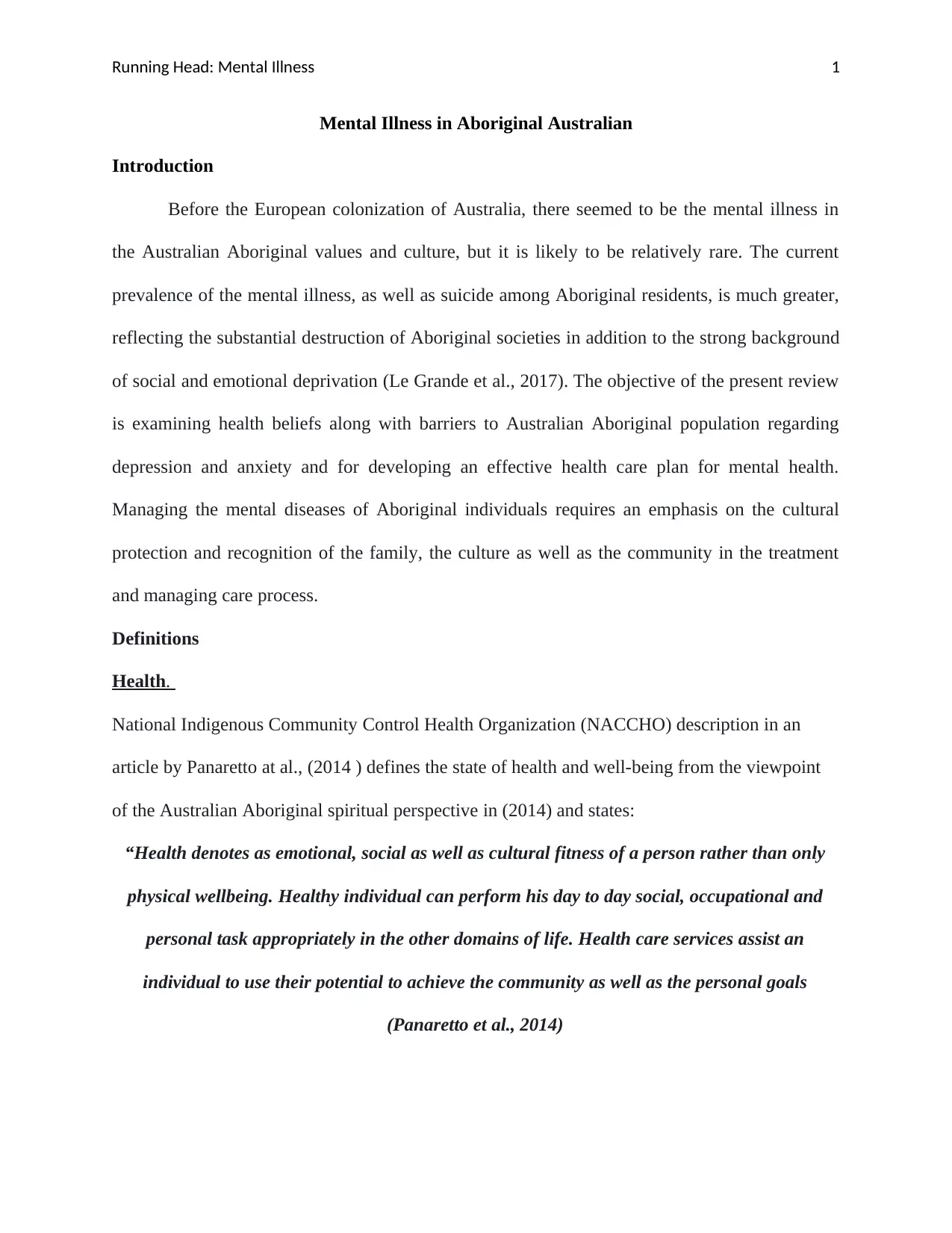
Running Head: Mental Illness 1
Mental Illness in Aboriginal Australian
Introduction
Before the European colonization of Australia, there seemed to be the mental illness in
the Australian Aboriginal values and culture, but it is likely to be relatively rare. The current
prevalence of the mental illness, as well as suicide among Aboriginal residents, is much greater,
reflecting the substantial destruction of Aboriginal societies in addition to the strong background
of social and emotional deprivation (Le Grande et al., 2017). The objective of the present review
is examining health beliefs along with barriers to Australian Aboriginal population regarding
depression and anxiety and for developing an effective health care plan for mental health.
Managing the mental diseases of Aboriginal individuals requires an emphasis on the cultural
protection and recognition of the family, the culture as well as the community in the treatment
and managing care process.
Definitions
Health.
National Indigenous Community Control Health Organization (NACCHO) description in an
article by Panaretto at al., (2014 ) defines the state of health and well-being from the viewpoint
of the Australian Aboriginal spiritual perspective in (2014) and states:
“Health denotes as emotional, social as well as cultural fitness of a person rather than only
physical wellbeing. Healthy individual can perform his day to day social, occupational and
personal task appropriately in the other domains of life. Health care services assist an
individual to use their potential to achieve the community as well as the personal goals
(Panaretto et al., 2014)
Mental Illness in Aboriginal Australian
Introduction
Before the European colonization of Australia, there seemed to be the mental illness in
the Australian Aboriginal values and culture, but it is likely to be relatively rare. The current
prevalence of the mental illness, as well as suicide among Aboriginal residents, is much greater,
reflecting the substantial destruction of Aboriginal societies in addition to the strong background
of social and emotional deprivation (Le Grande et al., 2017). The objective of the present review
is examining health beliefs along with barriers to Australian Aboriginal population regarding
depression and anxiety and for developing an effective health care plan for mental health.
Managing the mental diseases of Aboriginal individuals requires an emphasis on the cultural
protection and recognition of the family, the culture as well as the community in the treatment
and managing care process.
Definitions
Health.
National Indigenous Community Control Health Organization (NACCHO) description in an
article by Panaretto at al., (2014 ) defines the state of health and well-being from the viewpoint
of the Australian Aboriginal spiritual perspective in (2014) and states:
“Health denotes as emotional, social as well as cultural fitness of a person rather than only
physical wellbeing. Healthy individual can perform his day to day social, occupational and
personal task appropriately in the other domains of life. Health care services assist an
individual to use their potential to achieve the community as well as the personal goals
(Panaretto et al., 2014)
Paraphrase This Document
Need a fresh take? Get an instant paraphrase of this document with our AI Paraphraser
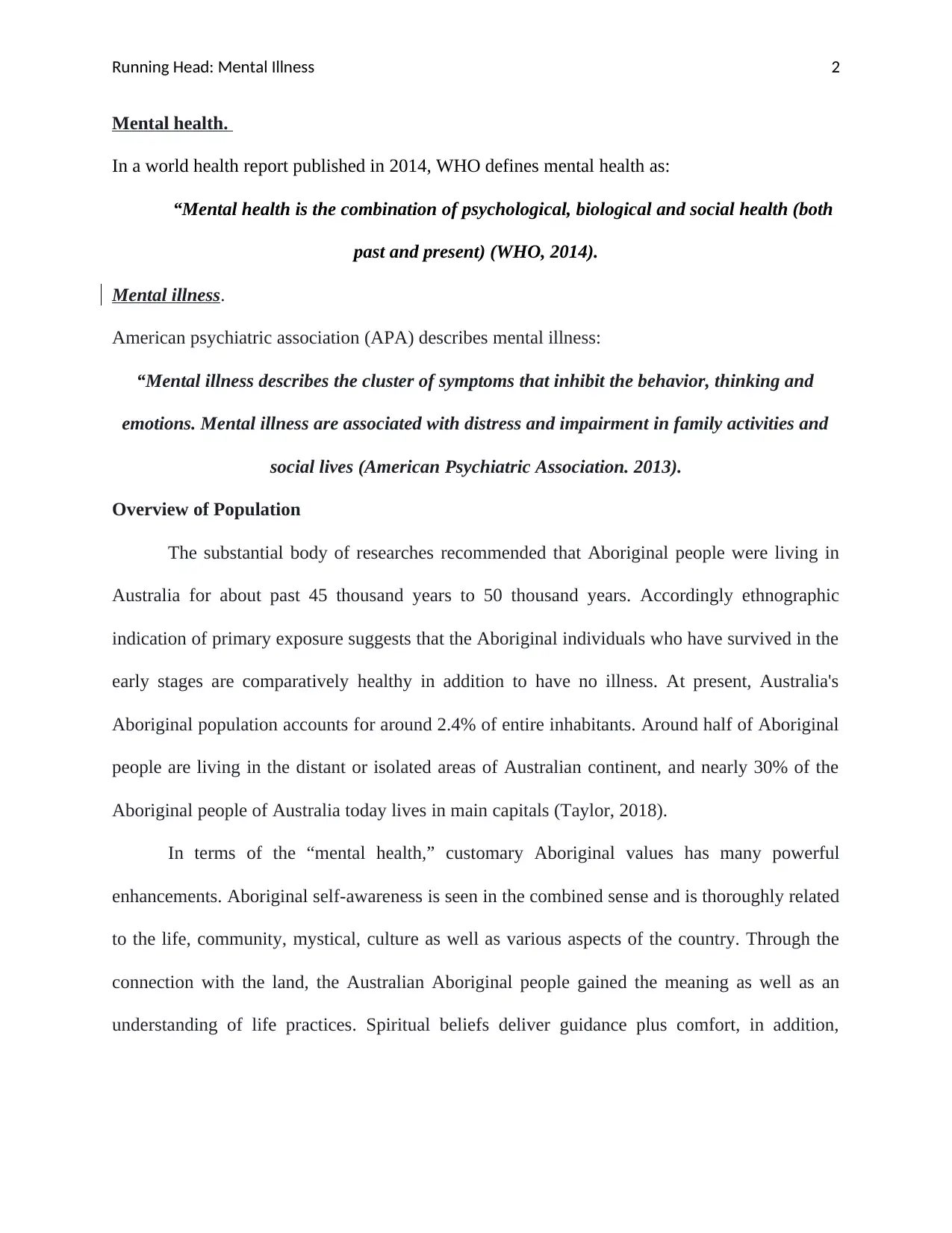
Running Head: Mental Illness 2
Mental health.
In a world health report published in 2014, WHO defines mental health as:
“Mental health is the combination of psychological, biological and social health (both
past and present) (WHO, 2014).
Mental illness.
American psychiatric association (APA) describes mental illness:
“Mental illness describes the cluster of symptoms that inhibit the behavior, thinking and
emotions. Mental illness are associated with distress and impairment in family activities and
social lives (American Psychiatric Association. 2013).
Overview of Population
The substantial body of researches recommended that Aboriginal people were living in
Australia for about past 45 thousand years to 50 thousand years. Accordingly ethnographic
indication of primary exposure suggests that the Aboriginal individuals who have survived in the
early stages are comparatively healthy in addition to have no illness. At present, Australia's
Aboriginal population accounts for around 2.4% of entire inhabitants. Around half of Aboriginal
people are living in the distant or isolated areas of Australian continent, and nearly 30% of the
Aboriginal people of Australia today lives in main capitals (Taylor, 2018).
In terms of the “mental health,” customary Aboriginal values has many powerful
enhancements. Aboriginal self-awareness is seen in the combined sense and is thoroughly related
to the life, community, mystical, culture as well as various aspects of the country. Through the
connection with the land, the Australian Aboriginal people gained the meaning as well as an
understanding of life practices. Spiritual beliefs deliver guidance plus comfort, in addition,
Mental health.
In a world health report published in 2014, WHO defines mental health as:
“Mental health is the combination of psychological, biological and social health (both
past and present) (WHO, 2014).
Mental illness.
American psychiatric association (APA) describes mental illness:
“Mental illness describes the cluster of symptoms that inhibit the behavior, thinking and
emotions. Mental illness are associated with distress and impairment in family activities and
social lives (American Psychiatric Association. 2013).
Overview of Population
The substantial body of researches recommended that Aboriginal people were living in
Australia for about past 45 thousand years to 50 thousand years. Accordingly ethnographic
indication of primary exposure suggests that the Aboriginal individuals who have survived in the
early stages are comparatively healthy in addition to have no illness. At present, Australia's
Aboriginal population accounts for around 2.4% of entire inhabitants. Around half of Aboriginal
people are living in the distant or isolated areas of Australian continent, and nearly 30% of the
Aboriginal people of Australia today lives in main capitals (Taylor, 2018).
In terms of the “mental health,” customary Aboriginal values has many powerful
enhancements. Aboriginal self-awareness is seen in the combined sense and is thoroughly related
to the life, community, mystical, culture as well as various aspects of the country. Through the
connection with the land, the Australian Aboriginal people gained the meaning as well as an
understanding of life practices. Spiritual beliefs deliver guidance plus comfort, in addition,
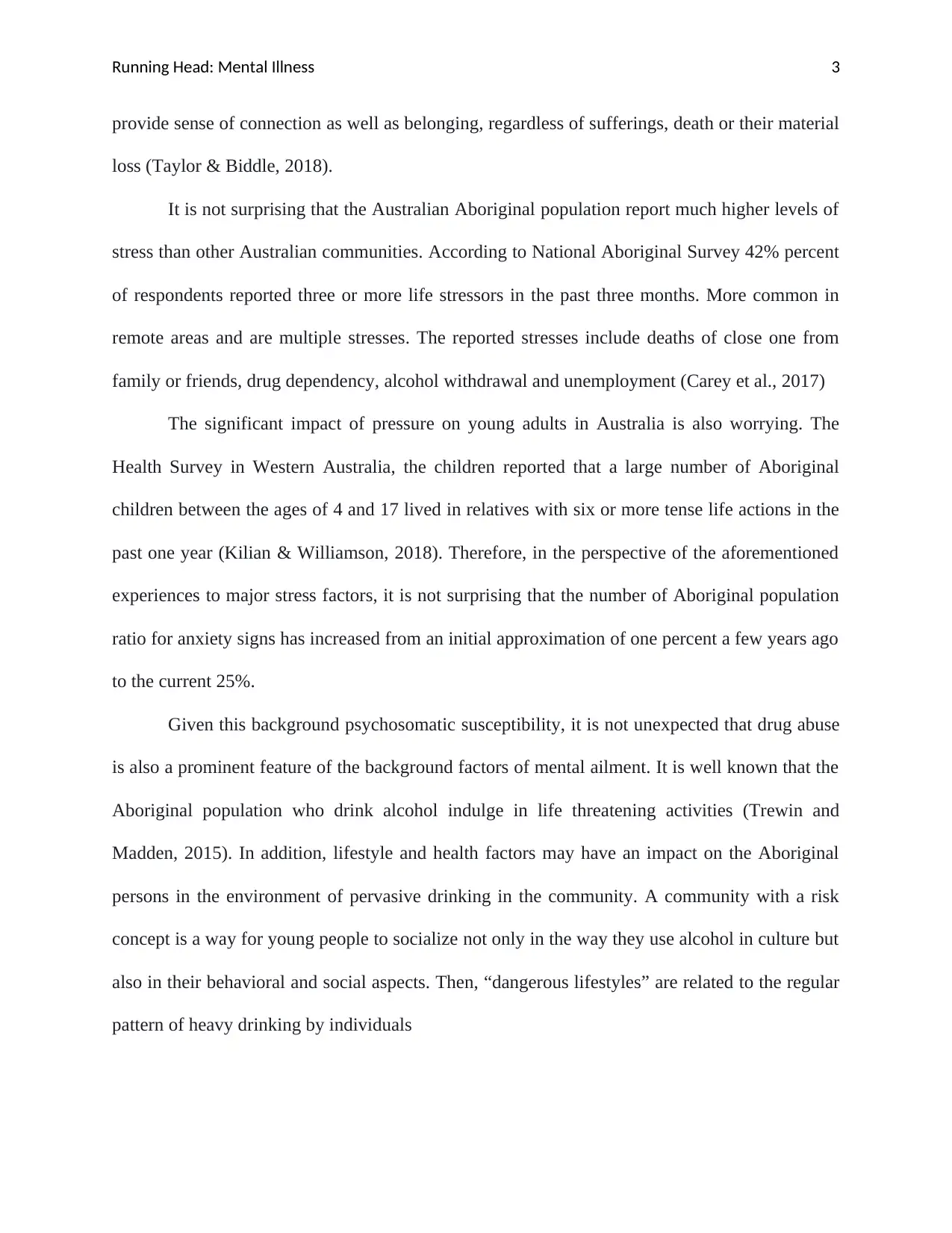
Running Head: Mental Illness 3
provide sense of connection as well as belonging, regardless of sufferings, death or their material
loss (Taylor & Biddle, 2018).
It is not surprising that the Australian Aboriginal population report much higher levels of
stress than other Australian communities. According to National Aboriginal Survey 42% percent
of respondents reported three or more life stressors in the past three months. More common in
remote areas and are multiple stresses. The reported stresses include deaths of close one from
family or friends, drug dependency, alcohol withdrawal and unemployment (Carey et al., 2017)
The significant impact of pressure on young adults in Australia is also worrying. The
Health Survey in Western Australia, the children reported that a large number of Aboriginal
children between the ages of 4 and 17 lived in relatives with six or more tense life actions in the
past one year (Kilian & Williamson, 2018). Therefore, in the perspective of the aforementioned
experiences to major stress factors, it is not surprising that the number of Aboriginal population
ratio for anxiety signs has increased from an initial approximation of one percent a few years ago
to the current 25%.
Given this background psychosomatic susceptibility, it is not unexpected that drug abuse
is also a prominent feature of the background factors of mental ailment. It is well known that the
Aboriginal population who drink alcohol indulge in life threatening activities (Trewin and
Madden, 2015). In addition, lifestyle and health factors may have an impact on the Aboriginal
persons in the environment of pervasive drinking in the community. A community with a risk
concept is a way for young people to socialize not only in the way they use alcohol in culture but
also in their behavioral and social aspects. Then, “dangerous lifestyles” are related to the regular
pattern of heavy drinking by individuals
provide sense of connection as well as belonging, regardless of sufferings, death or their material
loss (Taylor & Biddle, 2018).
It is not surprising that the Australian Aboriginal population report much higher levels of
stress than other Australian communities. According to National Aboriginal Survey 42% percent
of respondents reported three or more life stressors in the past three months. More common in
remote areas and are multiple stresses. The reported stresses include deaths of close one from
family or friends, drug dependency, alcohol withdrawal and unemployment (Carey et al., 2017)
The significant impact of pressure on young adults in Australia is also worrying. The
Health Survey in Western Australia, the children reported that a large number of Aboriginal
children between the ages of 4 and 17 lived in relatives with six or more tense life actions in the
past one year (Kilian & Williamson, 2018). Therefore, in the perspective of the aforementioned
experiences to major stress factors, it is not surprising that the number of Aboriginal population
ratio for anxiety signs has increased from an initial approximation of one percent a few years ago
to the current 25%.
Given this background psychosomatic susceptibility, it is not unexpected that drug abuse
is also a prominent feature of the background factors of mental ailment. It is well known that the
Aboriginal population who drink alcohol indulge in life threatening activities (Trewin and
Madden, 2015). In addition, lifestyle and health factors may have an impact on the Aboriginal
persons in the environment of pervasive drinking in the community. A community with a risk
concept is a way for young people to socialize not only in the way they use alcohol in culture but
also in their behavioral and social aspects. Then, “dangerous lifestyles” are related to the regular
pattern of heavy drinking by individuals
⊘ This is a preview!⊘
Do you want full access?
Subscribe today to unlock all pages.

Trusted by 1+ million students worldwide
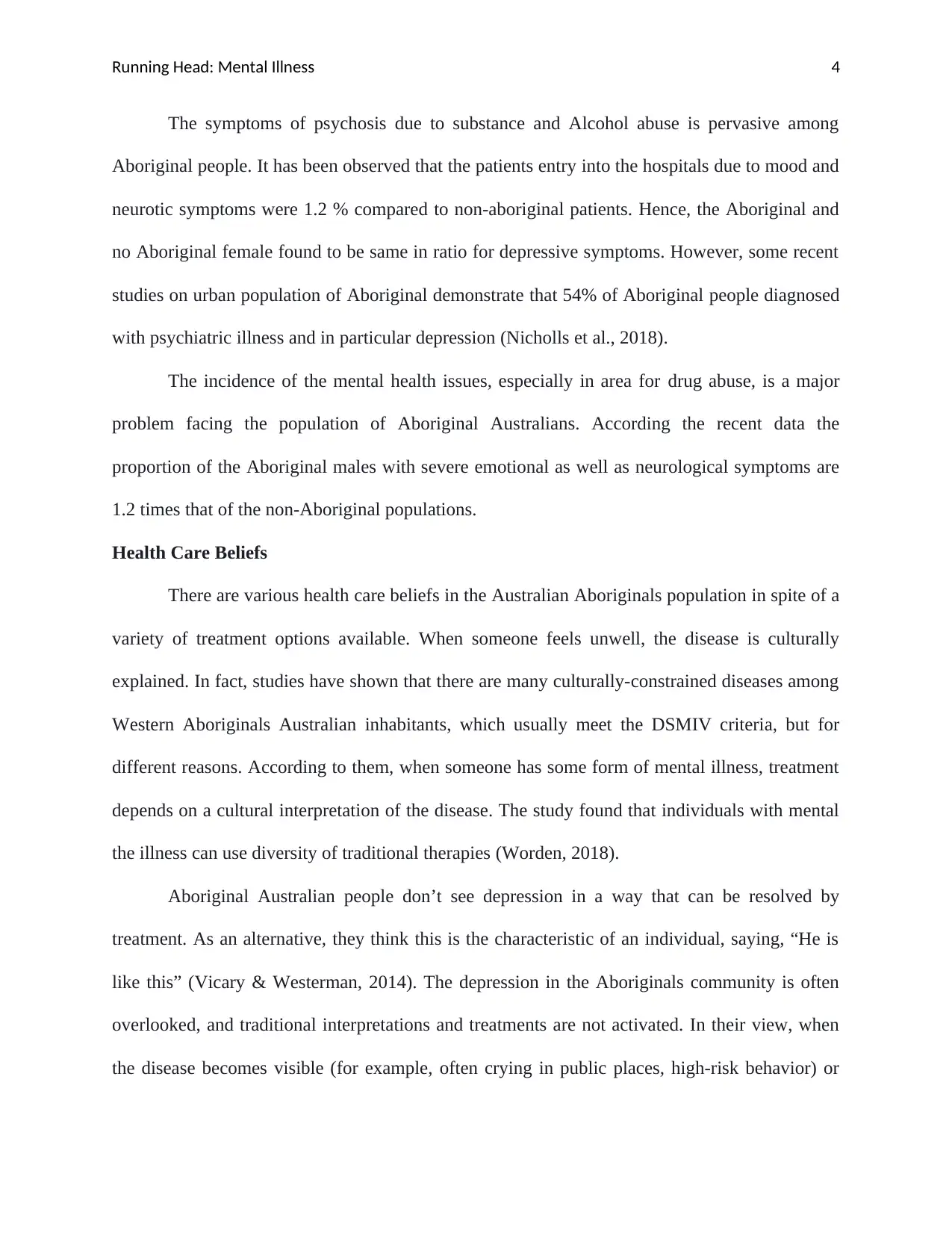
Running Head: Mental Illness 4
The symptoms of psychosis due to substance and Alcohol abuse is pervasive among
Aboriginal people. It has been observed that the patients entry into the hospitals due to mood and
neurotic symptoms were 1.2 % compared to non-aboriginal patients. Hence, the Aboriginal and
no Aboriginal female found to be same in ratio for depressive symptoms. However, some recent
studies on urban population of Aboriginal demonstrate that 54% of Aboriginal people diagnosed
with psychiatric illness and in particular depression (Nicholls et al., 2018).
The incidence of the mental health issues, especially in area for drug abuse, is a major
problem facing the population of Aboriginal Australians. According the recent data the
proportion of the Aboriginal males with severe emotional as well as neurological symptoms are
1.2 times that of the non-Aboriginal populations.
Health Care Beliefs
There are various health care beliefs in the Australian Aboriginals population in spite of a
variety of treatment options available. When someone feels unwell, the disease is culturally
explained. In fact, studies have shown that there are many culturally-constrained diseases among
Western Aboriginals Australian inhabitants, which usually meet the DSMIV criteria, but for
different reasons. According to them, when someone has some form of mental illness, treatment
depends on a cultural interpretation of the disease. The study found that individuals with mental
the illness can use diversity of traditional therapies (Worden, 2018).
Aboriginal Australian people don’t see depression in a way that can be resolved by
treatment. As an alternative, they think this is the characteristic of an individual, saying, “He is
like this” (Vicary & Westerman, 2014). The depression in the Aboriginals community is often
overlooked, and traditional interpretations and treatments are not activated. In their view, when
the disease becomes visible (for example, often crying in public places, high-risk behavior) or
The symptoms of psychosis due to substance and Alcohol abuse is pervasive among
Aboriginal people. It has been observed that the patients entry into the hospitals due to mood and
neurotic symptoms were 1.2 % compared to non-aboriginal patients. Hence, the Aboriginal and
no Aboriginal female found to be same in ratio for depressive symptoms. However, some recent
studies on urban population of Aboriginal demonstrate that 54% of Aboriginal people diagnosed
with psychiatric illness and in particular depression (Nicholls et al., 2018).
The incidence of the mental health issues, especially in area for drug abuse, is a major
problem facing the population of Aboriginal Australians. According the recent data the
proportion of the Aboriginal males with severe emotional as well as neurological symptoms are
1.2 times that of the non-Aboriginal populations.
Health Care Beliefs
There are various health care beliefs in the Australian Aboriginals population in spite of a
variety of treatment options available. When someone feels unwell, the disease is culturally
explained. In fact, studies have shown that there are many culturally-constrained diseases among
Western Aboriginals Australian inhabitants, which usually meet the DSMIV criteria, but for
different reasons. According to them, when someone has some form of mental illness, treatment
depends on a cultural interpretation of the disease. The study found that individuals with mental
the illness can use diversity of traditional therapies (Worden, 2018).
Aboriginal Australian people don’t see depression in a way that can be resolved by
treatment. As an alternative, they think this is the characteristic of an individual, saying, “He is
like this” (Vicary & Westerman, 2014). The depression in the Aboriginals community is often
overlooked, and traditional interpretations and treatments are not activated. In their view, when
the disease becomes visible (for example, often crying in public places, high-risk behavior) or
Paraphrase This Document
Need a fresh take? Get an instant paraphrase of this document with our AI Paraphraser

Running Head: Mental Illness 5
causes behavioral disorders (such as suicidal behavior), mental illnesses shift from characteristic
diseases to pathological diseases.
Beliefs of the mental illness of several types of the professional assistance are also
common among Australian Aboriginal groups. For instance, if an individual with the mental
disorder have faith in that it is unlikely that a counselling psychiatrist or psychologist will be
cooperative, this will lessen their chances of getting suitable help. Similarly, there are beliefs
about the type of treatment. Because of the fear of side effects as well as belief that drugs treat
symptoms instead of causes, attitudes toward psychotropic substances are mainly negative. This
belief may affect adherence to prescription drugs (Jorm et al., 2015).
Studies have shown that more energy should be spent on educating Australian Aboriginal
people about mental illness and overcoming the stigma of asking for help on these issues. This is
especially true for depression, which is often not recognized and treated, and may, therefore, be
one of the reasons for the high rate of suicide among Australian aborigines (Ridani et al., 2015).
Western as well as Aboriginal psychology should coordinate their work to deliver the most
effective management though building resilience among Aboriginal Australian individuals,
families as well as communities.
Implications for Care Planning
The study found many problems that led to mental health insults that had a direct as well
as indirect impact on the access and excellence of the care for Australian aboriginal patients with
the mental illness. Recognize that definite issues that could be changed via targeted initiatives
(Knaak & Patten, 2016). Individuals with the psychological illness experience often describe that
that many health professionals who have been in contact with them feel devalued, dismissed and
dehumanized (Hamilton et al., 2016).
causes behavioral disorders (such as suicidal behavior), mental illnesses shift from characteristic
diseases to pathological diseases.
Beliefs of the mental illness of several types of the professional assistance are also
common among Australian Aboriginal groups. For instance, if an individual with the mental
disorder have faith in that it is unlikely that a counselling psychiatrist or psychologist will be
cooperative, this will lessen their chances of getting suitable help. Similarly, there are beliefs
about the type of treatment. Because of the fear of side effects as well as belief that drugs treat
symptoms instead of causes, attitudes toward psychotropic substances are mainly negative. This
belief may affect adherence to prescription drugs (Jorm et al., 2015).
Studies have shown that more energy should be spent on educating Australian Aboriginal
people about mental illness and overcoming the stigma of asking for help on these issues. This is
especially true for depression, which is often not recognized and treated, and may, therefore, be
one of the reasons for the high rate of suicide among Australian aborigines (Ridani et al., 2015).
Western as well as Aboriginal psychology should coordinate their work to deliver the most
effective management though building resilience among Aboriginal Australian individuals,
families as well as communities.
Implications for Care Planning
The study found many problems that led to mental health insults that had a direct as well
as indirect impact on the access and excellence of the care for Australian aboriginal patients with
the mental illness. Recognize that definite issues that could be changed via targeted initiatives
(Knaak & Patten, 2016). Individuals with the psychological illness experience often describe that
that many health professionals who have been in contact with them feel devalued, dismissed and
dehumanized (Hamilton et al., 2016).
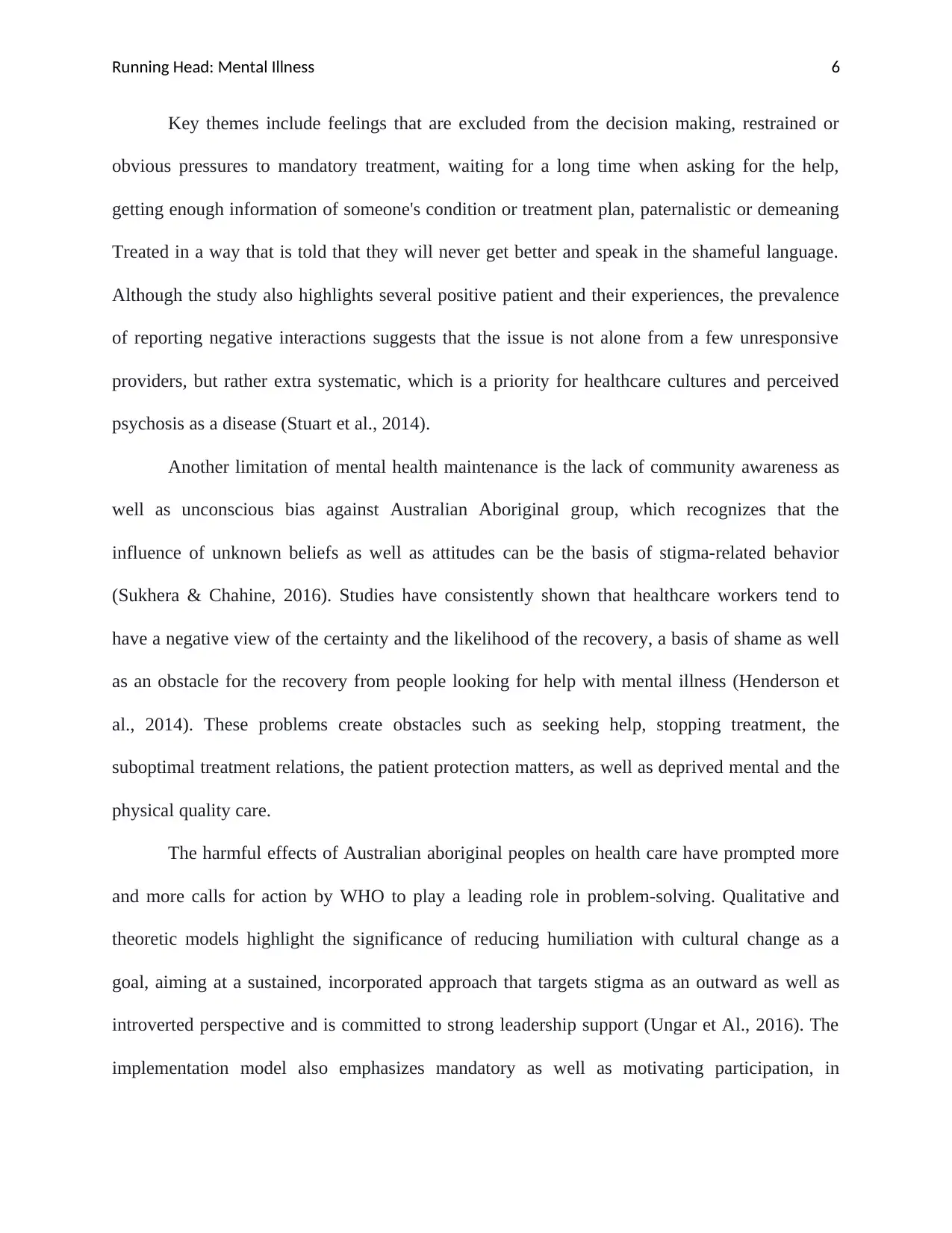
Running Head: Mental Illness 6
Key themes include feelings that are excluded from the decision making, restrained or
obvious pressures to mandatory treatment, waiting for a long time when asking for the help,
getting enough information of someone's condition or treatment plan, paternalistic or demeaning
Treated in a way that is told that they will never get better and speak in the shameful language.
Although the study also highlights several positive patient and their experiences, the prevalence
of reporting negative interactions suggests that the issue is not alone from a few unresponsive
providers, but rather extra systematic, which is a priority for healthcare cultures and perceived
psychosis as a disease (Stuart et al., 2014).
Another limitation of mental health maintenance is the lack of community awareness as
well as unconscious bias against Australian Aboriginal group, which recognizes that the
influence of unknown beliefs as well as attitudes can be the basis of stigma-related behavior
(Sukhera & Chahine, 2016). Studies have consistently shown that healthcare workers tend to
have a negative view of the certainty and the likelihood of the recovery, a basis of shame as well
as an obstacle for the recovery from people looking for help with mental illness (Henderson et
al., 2014). These problems create obstacles such as seeking help, stopping treatment, the
suboptimal treatment relations, the patient protection matters, as well as deprived mental and the
physical quality care.
The harmful effects of Australian aboriginal peoples on health care have prompted more
and more calls for action by WHO to play a leading role in problem-solving. Qualitative and
theoretic models highlight the significance of reducing humiliation with cultural change as a
goal, aiming at a sustained, incorporated approach that targets stigma as an outward as well as
introverted perspective and is committed to strong leadership support (Ungar et Al., 2016). The
implementation model also emphasizes mandatory as well as motivating participation, in
Key themes include feelings that are excluded from the decision making, restrained or
obvious pressures to mandatory treatment, waiting for a long time when asking for the help,
getting enough information of someone's condition or treatment plan, paternalistic or demeaning
Treated in a way that is told that they will never get better and speak in the shameful language.
Although the study also highlights several positive patient and their experiences, the prevalence
of reporting negative interactions suggests that the issue is not alone from a few unresponsive
providers, but rather extra systematic, which is a priority for healthcare cultures and perceived
psychosis as a disease (Stuart et al., 2014).
Another limitation of mental health maintenance is the lack of community awareness as
well as unconscious bias against Australian Aboriginal group, which recognizes that the
influence of unknown beliefs as well as attitudes can be the basis of stigma-related behavior
(Sukhera & Chahine, 2016). Studies have consistently shown that healthcare workers tend to
have a negative view of the certainty and the likelihood of the recovery, a basis of shame as well
as an obstacle for the recovery from people looking for help with mental illness (Henderson et
al., 2014). These problems create obstacles such as seeking help, stopping treatment, the
suboptimal treatment relations, the patient protection matters, as well as deprived mental and the
physical quality care.
The harmful effects of Australian aboriginal peoples on health care have prompted more
and more calls for action by WHO to play a leading role in problem-solving. Qualitative and
theoretic models highlight the significance of reducing humiliation with cultural change as a
goal, aiming at a sustained, incorporated approach that targets stigma as an outward as well as
introverted perspective and is committed to strong leadership support (Ungar et Al., 2016). The
implementation model also emphasizes mandatory as well as motivating participation, in
⊘ This is a preview!⊘
Do you want full access?
Subscribe today to unlock all pages.

Trusted by 1+ million students worldwide
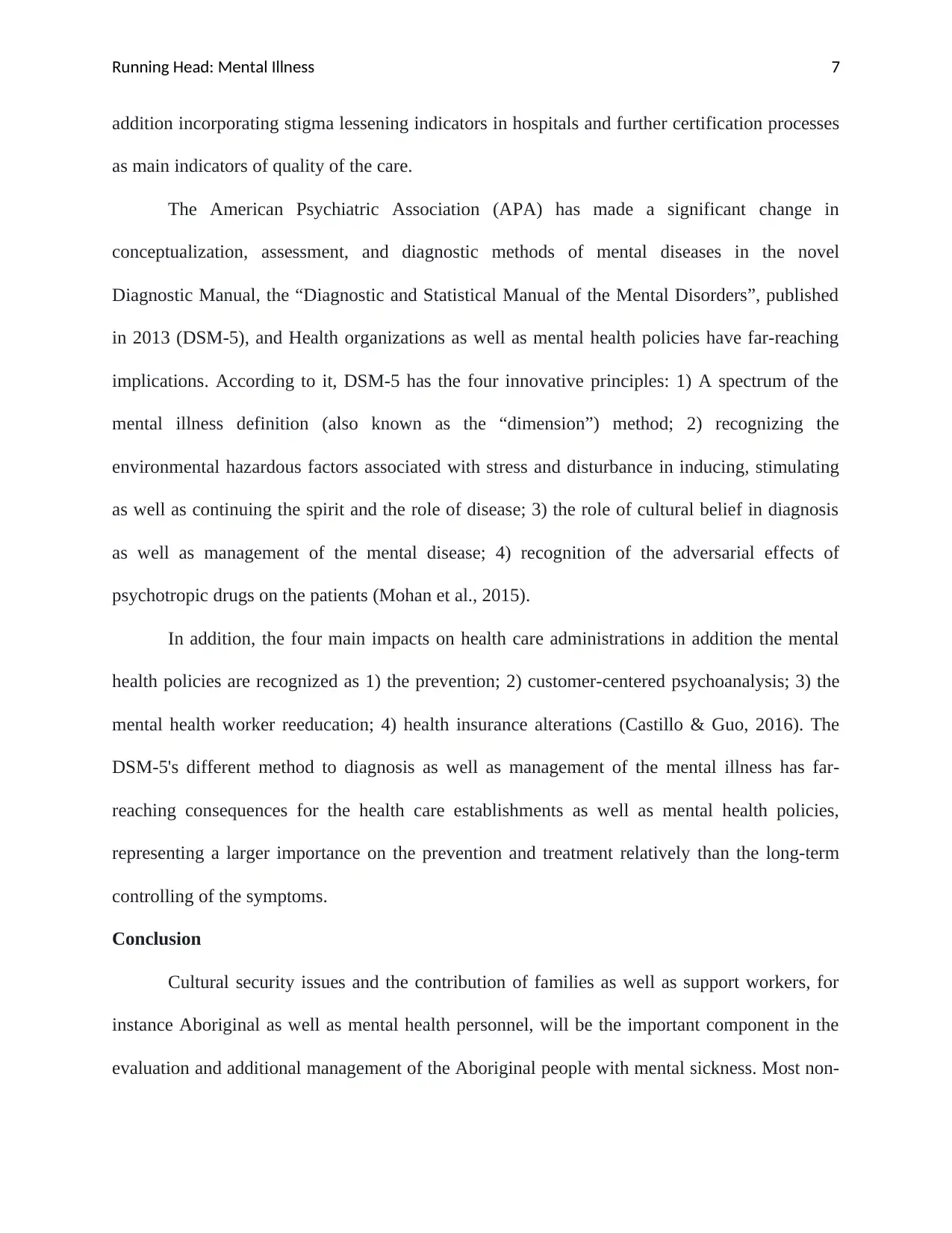
Running Head: Mental Illness 7
addition incorporating stigma lessening indicators in hospitals and further certification processes
as main indicators of quality of the care.
The American Psychiatric Association (APA) has made a significant change in
conceptualization, assessment, and diagnostic methods of mental diseases in the novel
Diagnostic Manual, the “Diagnostic and Statistical Manual of the Mental Disorders”, published
in 2013 (DSM-5), and Health organizations as well as mental health policies have far-reaching
implications. According to it, DSM-5 has the four innovative principles: 1) A spectrum of the
mental illness definition (also known as the “dimension”) method; 2) recognizing the
environmental hazardous factors associated with stress and disturbance in inducing, stimulating
as well as continuing the spirit and the role of disease; 3) the role of cultural belief in diagnosis
as well as management of the mental disease; 4) recognition of the adversarial effects of
psychotropic drugs on the patients (Mohan et al., 2015).
In addition, the four main impacts on health care administrations in addition the mental
health policies are recognized as 1) the prevention; 2) customer-centered psychoanalysis; 3) the
mental health worker reeducation; 4) health insurance alterations (Castillo & Guo, 2016). The
DSM-5's different method to diagnosis as well as management of the mental illness has far-
reaching consequences for the health care establishments as well as mental health policies,
representing a larger importance on the prevention and treatment relatively than the long-term
controlling of the symptoms.
Conclusion
Cultural security issues and the contribution of families as well as support workers, for
instance Aboriginal as well as mental health personnel, will be the important component in the
evaluation and additional management of the Aboriginal people with mental sickness. Most non-
addition incorporating stigma lessening indicators in hospitals and further certification processes
as main indicators of quality of the care.
The American Psychiatric Association (APA) has made a significant change in
conceptualization, assessment, and diagnostic methods of mental diseases in the novel
Diagnostic Manual, the “Diagnostic and Statistical Manual of the Mental Disorders”, published
in 2013 (DSM-5), and Health organizations as well as mental health policies have far-reaching
implications. According to it, DSM-5 has the four innovative principles: 1) A spectrum of the
mental illness definition (also known as the “dimension”) method; 2) recognizing the
environmental hazardous factors associated with stress and disturbance in inducing, stimulating
as well as continuing the spirit and the role of disease; 3) the role of cultural belief in diagnosis
as well as management of the mental disease; 4) recognition of the adversarial effects of
psychotropic drugs on the patients (Mohan et al., 2015).
In addition, the four main impacts on health care administrations in addition the mental
health policies are recognized as 1) the prevention; 2) customer-centered psychoanalysis; 3) the
mental health worker reeducation; 4) health insurance alterations (Castillo & Guo, 2016). The
DSM-5's different method to diagnosis as well as management of the mental illness has far-
reaching consequences for the health care establishments as well as mental health policies,
representing a larger importance on the prevention and treatment relatively than the long-term
controlling of the symptoms.
Conclusion
Cultural security issues and the contribution of families as well as support workers, for
instance Aboriginal as well as mental health personnel, will be the important component in the
evaluation and additional management of the Aboriginal people with mental sickness. Most non-
Paraphrase This Document
Need a fresh take? Get an instant paraphrase of this document with our AI Paraphraser

Running Head: Mental Illness 8
Aboriginal practitioners need some guidance to develop the skills and knowledge needed to build
strong therapeutic alliances with Aboriginal clients. Other strategies, for instance the
establishment of a skilled Aboriginal health school to develop as well as promote proficiency in
providing health plus community policy enterprises to Aboriginal Australian populations, it
could be considered a benefit. First, attention should be paid to identifying barriers to the access
as well as quality care resulting from the shameful process in terms of the personal as well as
interpersonal stigma in addition identifying solutions that could be implemented in the existing
structures.
Aboriginal practitioners need some guidance to develop the skills and knowledge needed to build
strong therapeutic alliances with Aboriginal clients. Other strategies, for instance the
establishment of a skilled Aboriginal health school to develop as well as promote proficiency in
providing health plus community policy enterprises to Aboriginal Australian populations, it
could be considered a benefit. First, attention should be paid to identifying barriers to the access
as well as quality care resulting from the shameful process in terms of the personal as well as
interpersonal stigma in addition identifying solutions that could be implemented in the existing
structures.
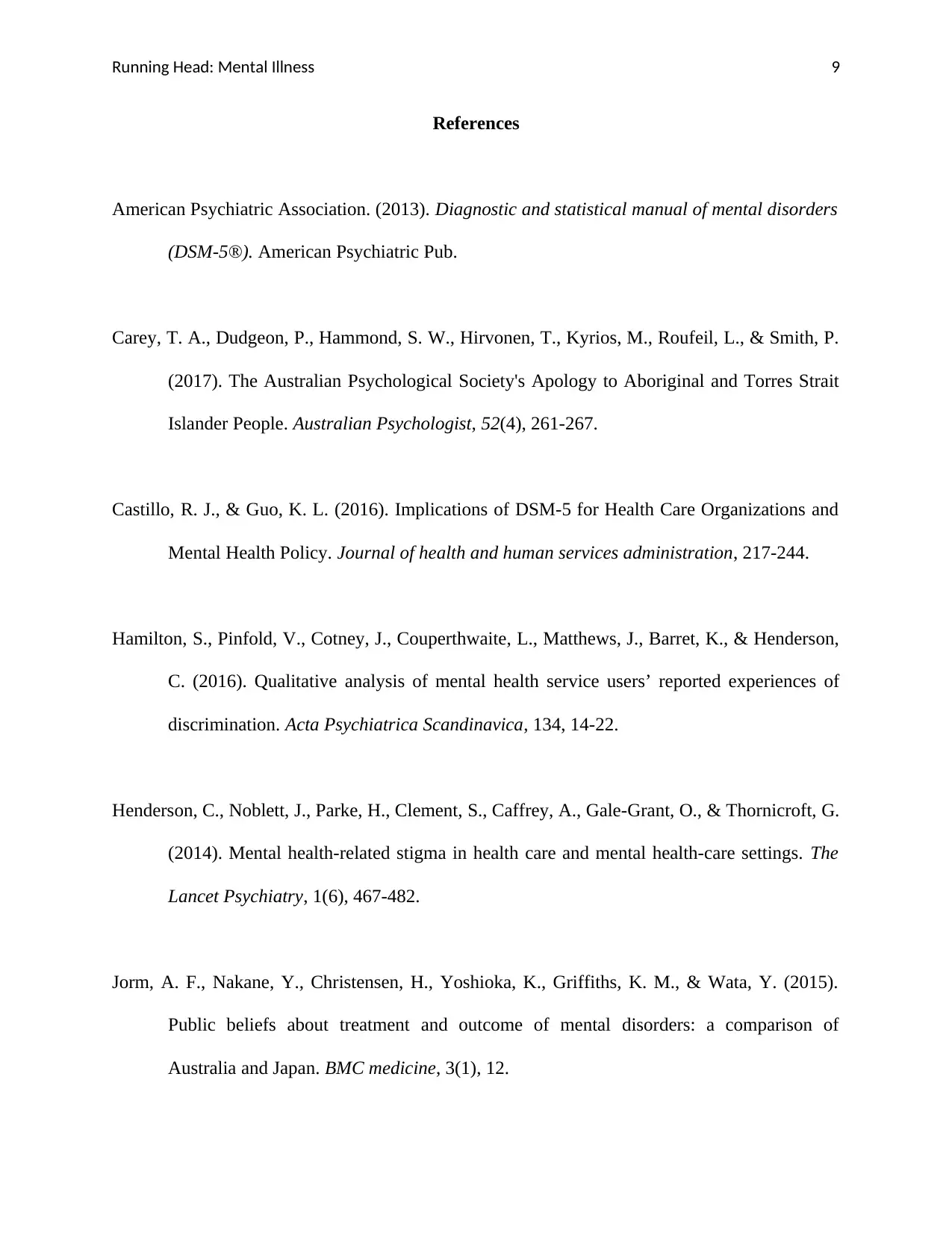
Running Head: Mental Illness 9
References
American Psychiatric Association. (2013). Diagnostic and statistical manual of mental disorders
(DSM-5®). American Psychiatric Pub.
Carey, T. A., Dudgeon, P., Hammond, S. W., Hirvonen, T., Kyrios, M., Roufeil, L., & Smith, P.
(2017). The Australian Psychological Society's Apology to Aboriginal and Torres Strait
Islander People. Australian Psychologist, 52(4), 261-267.
Castillo, R. J., & Guo, K. L. (2016). Implications of DSM-5 for Health Care Organizations and
Mental Health Policy. Journal of health and human services administration, 217-244.
Hamilton, S., Pinfold, V., Cotney, J., Couperthwaite, L., Matthews, J., Barret, K., & Henderson,
C. (2016). Qualitative analysis of mental health service users’ reported experiences of
discrimination. Acta Psychiatrica Scandinavica, 134, 14-22.
Henderson, C., Noblett, J., Parke, H., Clement, S., Caffrey, A., Gale-Grant, O., & Thornicroft, G.
(2014). Mental health-related stigma in health care and mental health-care settings. The
Lancet Psychiatry, 1(6), 467-482.
Jorm, A. F., Nakane, Y., Christensen, H., Yoshioka, K., Griffiths, K. M., & Wata, Y. (2015).
Public beliefs about treatment and outcome of mental disorders: a comparison of
Australia and Japan. BMC medicine, 3(1), 12.
References
American Psychiatric Association. (2013). Diagnostic and statistical manual of mental disorders
(DSM-5®). American Psychiatric Pub.
Carey, T. A., Dudgeon, P., Hammond, S. W., Hirvonen, T., Kyrios, M., Roufeil, L., & Smith, P.
(2017). The Australian Psychological Society's Apology to Aboriginal and Torres Strait
Islander People. Australian Psychologist, 52(4), 261-267.
Castillo, R. J., & Guo, K. L. (2016). Implications of DSM-5 for Health Care Organizations and
Mental Health Policy. Journal of health and human services administration, 217-244.
Hamilton, S., Pinfold, V., Cotney, J., Couperthwaite, L., Matthews, J., Barret, K., & Henderson,
C. (2016). Qualitative analysis of mental health service users’ reported experiences of
discrimination. Acta Psychiatrica Scandinavica, 134, 14-22.
Henderson, C., Noblett, J., Parke, H., Clement, S., Caffrey, A., Gale-Grant, O., & Thornicroft, G.
(2014). Mental health-related stigma in health care and mental health-care settings. The
Lancet Psychiatry, 1(6), 467-482.
Jorm, A. F., Nakane, Y., Christensen, H., Yoshioka, K., Griffiths, K. M., & Wata, Y. (2015).
Public beliefs about treatment and outcome of mental disorders: a comparison of
Australia and Japan. BMC medicine, 3(1), 12.
⊘ This is a preview!⊘
Do you want full access?
Subscribe today to unlock all pages.

Trusted by 1+ million students worldwide
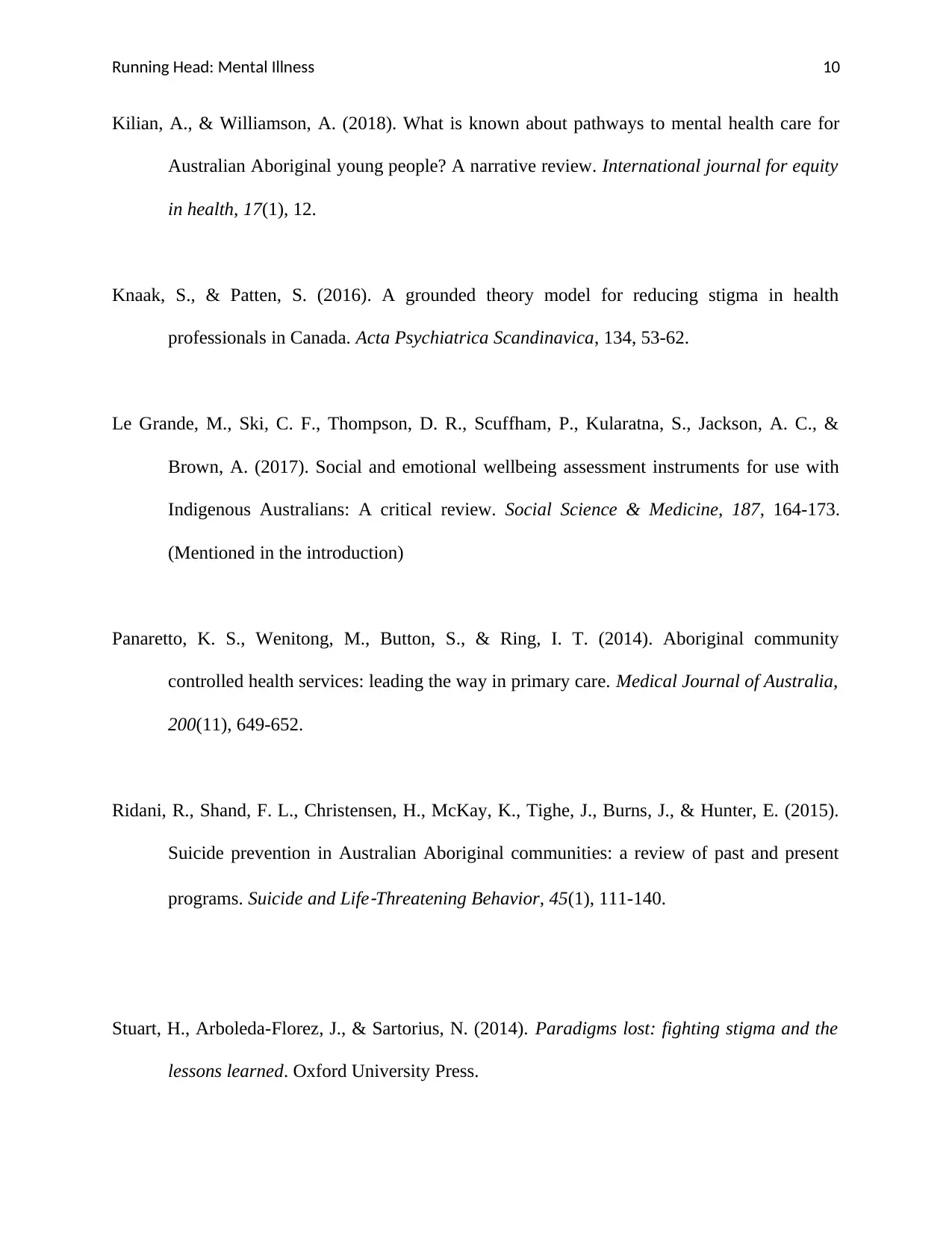
Running Head: Mental Illness 10
Kilian, A., & Williamson, A. (2018). What is known about pathways to mental health care for
Australian Aboriginal young people? A narrative review. International journal for equity
in health, 17(1), 12.
Knaak, S., & Patten, S. (2016). A grounded theory model for reducing stigma in health
professionals in Canada. Acta Psychiatrica Scandinavica, 134, 53-62.
Le Grande, M., Ski, C. F., Thompson, D. R., Scuffham, P., Kularatna, S., Jackson, A. C., &
Brown, A. (2017). Social and emotional wellbeing assessment instruments for use with
Indigenous Australians: A critical review. Social Science & Medicine, 187, 164-173.
(Mentioned in the introduction)
Panaretto, K. S., Wenitong, M., Button, S., & Ring, I. T. (2014). Aboriginal community
controlled health services: leading the way in primary care. Medical Journal of Australia,
200(11), 649-652.
Ridani, R., Shand, F. L., Christensen, H., McKay, K., Tighe, J., Burns, J., & Hunter, E. (2015).
Suicide prevention in Australian Aboriginal communities: a review of past and present
programs. Suicide and Life
‐Threatening Behavior, 45(1), 111-140.
Stuart, H., Arboleda-Florez, J., & Sartorius, N. (2014). Paradigms lost: fighting stigma and the
lessons learned. Oxford University Press.
Kilian, A., & Williamson, A. (2018). What is known about pathways to mental health care for
Australian Aboriginal young people? A narrative review. International journal for equity
in health, 17(1), 12.
Knaak, S., & Patten, S. (2016). A grounded theory model for reducing stigma in health
professionals in Canada. Acta Psychiatrica Scandinavica, 134, 53-62.
Le Grande, M., Ski, C. F., Thompson, D. R., Scuffham, P., Kularatna, S., Jackson, A. C., &
Brown, A. (2017). Social and emotional wellbeing assessment instruments for use with
Indigenous Australians: A critical review. Social Science & Medicine, 187, 164-173.
(Mentioned in the introduction)
Panaretto, K. S., Wenitong, M., Button, S., & Ring, I. T. (2014). Aboriginal community
controlled health services: leading the way in primary care. Medical Journal of Australia,
200(11), 649-652.
Ridani, R., Shand, F. L., Christensen, H., McKay, K., Tighe, J., Burns, J., & Hunter, E. (2015).
Suicide prevention in Australian Aboriginal communities: a review of past and present
programs. Suicide and Life
‐Threatening Behavior, 45(1), 111-140.
Stuart, H., Arboleda-Florez, J., & Sartorius, N. (2014). Paradigms lost: fighting stigma and the
lessons learned. Oxford University Press.
Paraphrase This Document
Need a fresh take? Get an instant paraphrase of this document with our AI Paraphraser
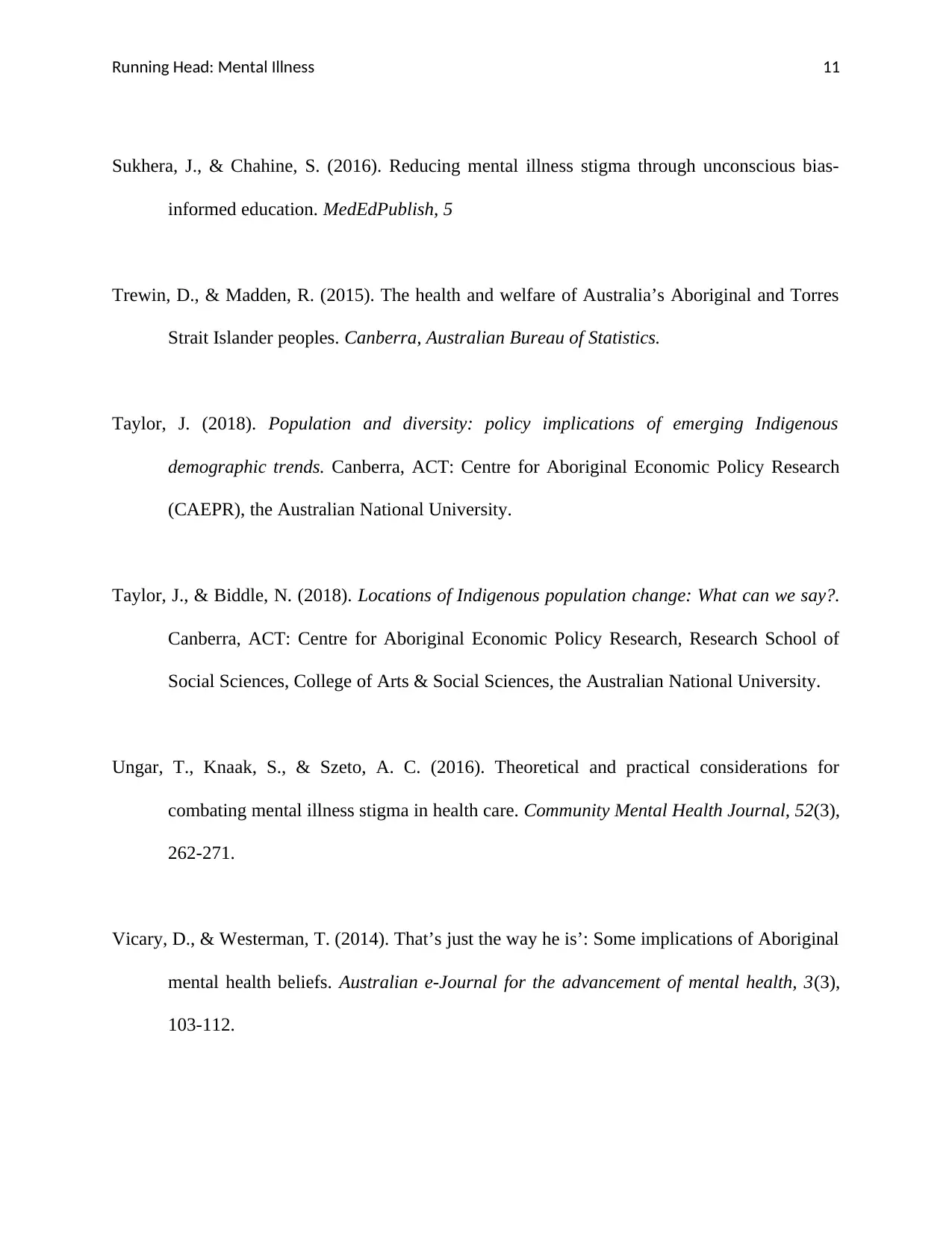
Running Head: Mental Illness 11
Sukhera, J., & Chahine, S. (2016). Reducing mental illness stigma through unconscious bias-
informed education. MedEdPublish, 5
Trewin, D., & Madden, R. (2015). The health and welfare of Australia’s Aboriginal and Torres
Strait Islander peoples. Canberra, Australian Bureau of Statistics.
Taylor, J. (2018). Population and diversity: policy implications of emerging Indigenous
demographic trends. Canberra, ACT: Centre for Aboriginal Economic Policy Research
(CAEPR), the Australian National University.
Taylor, J., & Biddle, N. (2018). Locations of Indigenous population change: What can we say?.
Canberra, ACT: Centre for Aboriginal Economic Policy Research, Research School of
Social Sciences, College of Arts & Social Sciences, the Australian National University.
Ungar, T., Knaak, S., & Szeto, A. C. (2016). Theoretical and practical considerations for
combating mental illness stigma in health care. Community Mental Health Journal, 52(3),
262-271.
Vicary, D., & Westerman, T. (2014). That’s just the way he is’: Some implications of Aboriginal
mental health beliefs. Australian e-Journal for the advancement of mental health, 3(3),
103-112.
Sukhera, J., & Chahine, S. (2016). Reducing mental illness stigma through unconscious bias-
informed education. MedEdPublish, 5
Trewin, D., & Madden, R. (2015). The health and welfare of Australia’s Aboriginal and Torres
Strait Islander peoples. Canberra, Australian Bureau of Statistics.
Taylor, J. (2018). Population and diversity: policy implications of emerging Indigenous
demographic trends. Canberra, ACT: Centre for Aboriginal Economic Policy Research
(CAEPR), the Australian National University.
Taylor, J., & Biddle, N. (2018). Locations of Indigenous population change: What can we say?.
Canberra, ACT: Centre for Aboriginal Economic Policy Research, Research School of
Social Sciences, College of Arts & Social Sciences, the Australian National University.
Ungar, T., Knaak, S., & Szeto, A. C. (2016). Theoretical and practical considerations for
combating mental illness stigma in health care. Community Mental Health Journal, 52(3),
262-271.
Vicary, D., & Westerman, T. (2014). That’s just the way he is’: Some implications of Aboriginal
mental health beliefs. Australian e-Journal for the advancement of mental health, 3(3),
103-112.
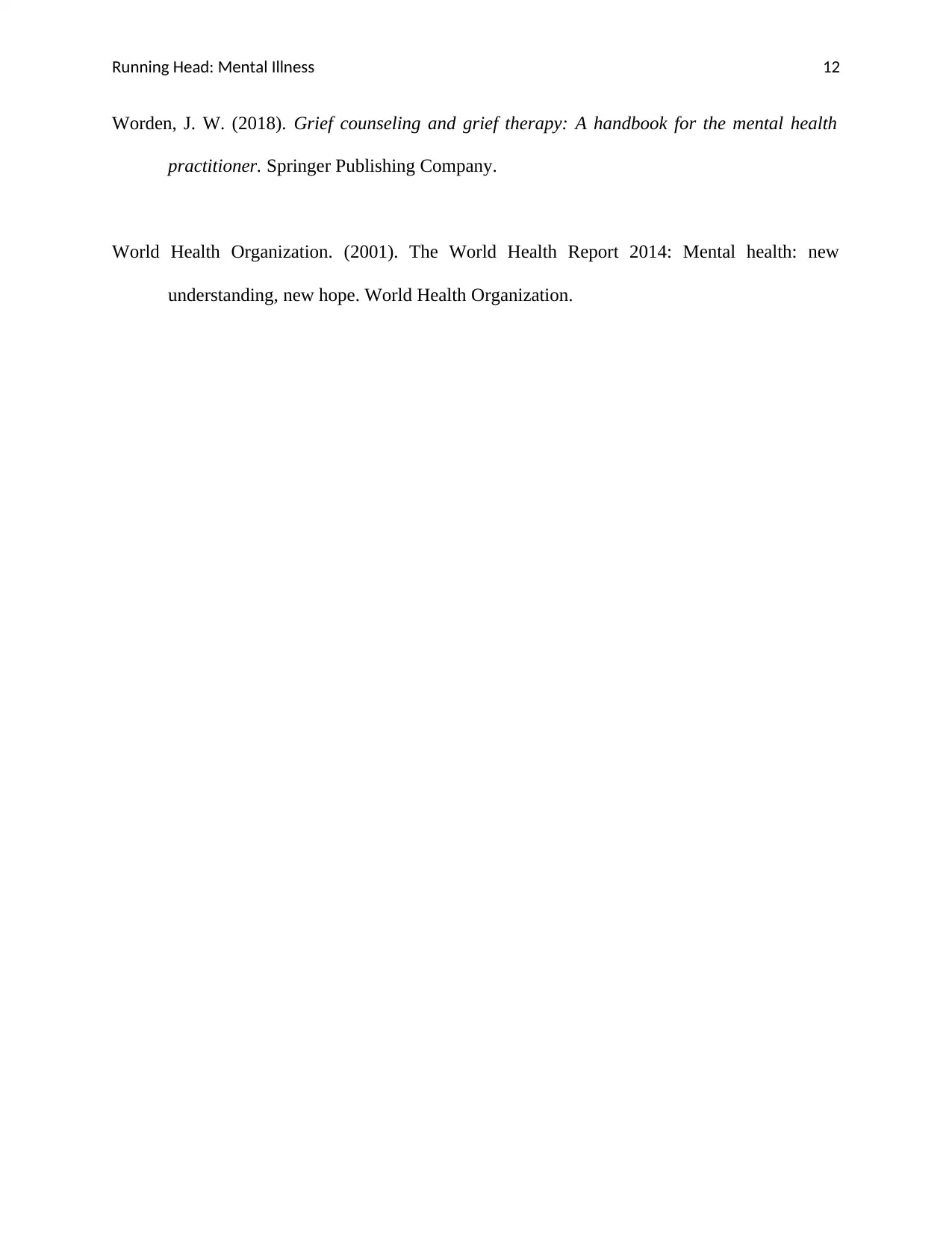
Running Head: Mental Illness 12
Worden, J. W. (2018). Grief counseling and grief therapy: A handbook for the mental health
practitioner. Springer Publishing Company.
World Health Organization. (2001). The World Health Report 2014: Mental health: new
understanding, new hope. World Health Organization.
Worden, J. W. (2018). Grief counseling and grief therapy: A handbook for the mental health
practitioner. Springer Publishing Company.
World Health Organization. (2001). The World Health Report 2014: Mental health: new
understanding, new hope. World Health Organization.
⊘ This is a preview!⊘
Do you want full access?
Subscribe today to unlock all pages.

Trusted by 1+ million students worldwide
1 out of 12
Related Documents
Your All-in-One AI-Powered Toolkit for Academic Success.
+13062052269
info@desklib.com
Available 24*7 on WhatsApp / Email
![[object Object]](/_next/static/media/star-bottom.7253800d.svg)
Unlock your academic potential
Copyright © 2020–2025 A2Z Services. All Rights Reserved. Developed and managed by ZUCOL.





